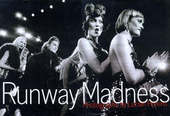
|
Runway Madness
Hardback
Main Details
| Title |
Runway Madness
|
| Authors and Contributors |
By (author) Robin Givhan
|
|
Photographs by Lucian Perkins
|
| Physical Properties |
| Format:Hardback | | Pages:120 | | Dimensions(mm): Height 250,Width 400 |
|
| Category/Genre | Photographs: collections
Fashion design and theory |
|---|
| ISBN/Barcode |
9780811821735
|
| Classifications | Dewey:746.92 |
|---|
| Audience | |
|---|
| Illustrations |
100 b&w and colour photographs
|
|
Publishing Details |
| Publisher |
Chronicle Books
|
| Imprint |
Chronicle Books
|
| Publication Date |
18 March 1999 |
| Publication Country |
United States
|
Description
More than 100 photographs from Pulitzer-Priz e winning photographer Lucian Perkins, many unpublished unti l this book, reveal the behind-the-scenes story of the infam ous New York fashion week. '
Author Biography
Lucian Perkins received a Pulitzer Prize in photography in 1995 and World Press Photo of the Year in 1996. A staff photographer for the Washington Post, he has covered the New York fashion shows for more than a decade. He lives in Washington, DC. Read an Robin Givhan is the fashion writer for the Washington Post and a three-time winner of the Atrium Award for fashion reporting.
ReviewsReviews from: AMERICAN PHOTO PHOTOGRAPHY ANNUAL It's a fashion show. There are beautiful models, fancy clothes, A-list celebs. There's also pushing and shoving by the mob of photographers crammed into a section at the foot of the runway trying to get shots worthy of running in fashion magazines. And then there's Pulitzer Prize-winning Washington Post staff photographer Lucian Perkins, stationed on the side of the runway, spinning around to photograph the onlookers or bending down to photograph a model's foot in mid-step. Perkins, who has been on general assignment with the Post since 1979, and won his Pulitzer for a four-year look at how poverty affected three generations of a family, has applied his documentary approach in covering the New York fashion shows for ten years. "I enjoy shooting the scene around the fashion shows," he says. "It's a very sort of bizarre culture." Perhaps because Perkins is more removed from the fashion world than some photographers, he is able to focus not so much on the clothes as the people behind the productions. The results are in Perkin's new book, Runway Madness. For the 45-year-old photographer, who just shot a story on environmental problems in Russia, doing the fashion shows isn't always easy. "Everyone comes to watch a show for 20 minutes, then they dash off to the next show," he says. "It is a really exhausting work." Lucian Perkins, a staff photographer for the Washington Post, has received numerous awards including "Newspaper Photographer of the Year" in 1994, by the National Press Photographers Association for a portfolio that included projects in Russia an his behind-the-scenes fashion work in New York, the focus of Runway Madness. The New York fashion world seems far removed from war-torn Chechnya, where Perkins photographed a small boy looking out the window of a bus, which won him World Press Photo of the Year in 1996, or the work for which he and Post reporter Leon Dash were awarded a Pulitzer Prize a four-year study of the effects of poverty on three generations of a Washington, DC family. But he has spent ten years covering New York's fashion shows, often outlandish, intensely theatrical events which transform New York's Bryant Park into a three-ring fashion circus every spring and fall. At the end of the 20th Century, when models are modern-day princesses adulterated by the press, given movie-star status and name recognition for wearing clothes prettily, there is no better time or a book like Runway Madness, which captures with documentary zeal and perfection, the artificial world of fashion. Perkin's photographs blend a subtle sense of humor with a documentarian's eye for the telling moment: a model lets down her guard backstage; a model preening like Narcissus in an available mirror in front of a table cluttered with a myriad of makeup tubes and compacts; fashion editors scrutinizing the shows, their seating arrangement an indication of their status and importance. Despite the constraints evident in shooting a fashion show, and the split-second timing required for an artful composition, Perkin's collection of photographs conveys the hectic energy, excitement and staged spontaneity of the New York shows. Especially striking is a line of models all identically dressed in long white gowns and several close-ups of the astonishing detail of haute couture garments.
|